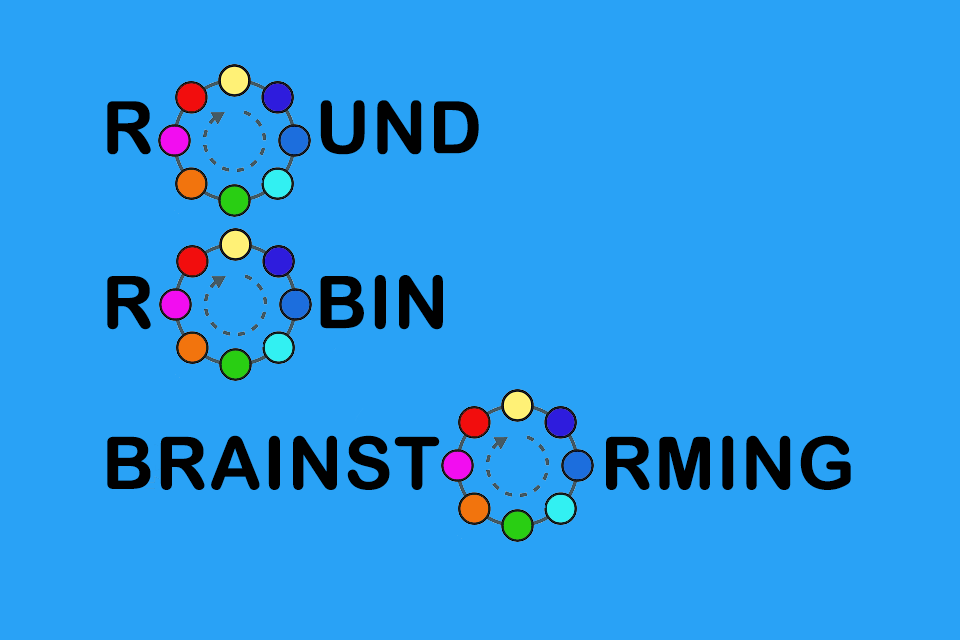What is a Round-Robin Brainstorming?
Smartpedia: Round-Robin Brainstorming is a format in which all participants in turn express their opinions and ideas on a common question.
Round-Robin Brainstorming – Ideation with Sequence
Brainstorming is a creativity technique in which a group of people work together to try to solve a task by collecting and developing ideas. Although the technique is used in many organisations, in practice there are two recurring problems in carrying it out correctly:
Extroverted employees contribute more often and in some cases more loudly than introverted employees.
And superiors are more likely to have their ideas heard.
In such situations, a variant of the classic idea generation on demand is suitable: the round-robin brainstorming.
Round-robin brainstorming is a format in which all participants present their opinions, ideas or approaches in an order to be determined – e.g. the order in which the participants sit around a table or in a room. First A presents, then B, then C, etc., until A presents again, then B, etc.
As a term, round robin has various meanings.¹ Originally, a “ruban rond” referred to a petition that was signed by the authors and supporters in a circle so that all voices appeared equal and no order of signatories could be determined.²
In the context of brainstorming, round robin refers to the principle of rotation whereby all participants have their say.
Round-Robin Brainstorming Procedure
The basic procedure of a rround-robin brainstorming is the same as that of many other variants:
- At the beginning, as always, there is a question or a problem. The task is to find ideas for this question or problem.
- Criticism of ideas and thoughts is forbidden to all participants, the moderator or the minute-taker.
- Any idea – however improbable it may sound – is a good idea.
- There is no copyright on ideas, i.e. ideas expressed may be further developed by all participants.
- It makes sense to use defined timeboxes.
Which timebox is the right one depends on the experience of the participants in conducting round-robin brainstorming, the professional knowledge in the context of the question or problem and on the concrete implementation of the format.
Two variants are conceivable:
- Variant 1: An initial time box of two or three minutes is agreed. All participants write down an initial idea and communicate it when asked by the facilitator. This is followed by another round with a similar time window and the moderator asking again for the identified ideas in the identical order as in the previous round. This procedure is repeated until an “appropriate” amount of ideas has been gathered.
- Variant 2: A longer timebox – 10 minutes, for example – is agreed upon and all participants write down their ideas. Here, too, they are asked in rows A, B, C, etc. and then again from the beginning.
In both variants, there should be a discussion and further development of the ideas, followed by a joint evaluation of the ideas. Both variants can be combined with brain-netting or starbursting.
Advantages and Disadvantages of Round-Robin Brainstorming
There are some obvious advantages to round-robin brainstorming:
- The brainstorming is calm, organised and structured.
- All participants have their say, regardless of hierarchy, prestige or communication preferences.
- The communication of ideas encourages more ideas.
The advantages may be offset by some disadvantages:
- Even if the brainstorming is structured, the discussion and evaluation of ideas is based on the same principles as a classic brainstorming: Extroverted employees and/or superiors can easily influence the next steps. Here, of course – as with other brainstorming formats – the moderator is particularly challenged.
- One brainstorming rule is that participants can contribute but do not have to. In this variant, however, everyone has to get involved. While in a classic format it may not be so important if individual participants contribute less, in this format it is directly noticeable if the person asked does not contribute a new idea. This may reinforce the rejection of the format.
Opinions vary as to whether round robin is brainstorming at all, because “using the brain to storm a problem” (this is how Alex Osborn, the inventor of brainstorming, paraphrased the creativity technique) does not actually take place. Problems are not solved in a storm and not with a concentrated charge of common energy. The generation of ideas and solutions takes place as a defined sequence, the problems are worked through rather than creatively mastered. In this sense, however, it would at least be a method of finding ideas.
Impulse to discuss
Notes:
[1] In addition to its use in petitions, the term is also used in IT as a method of processor or load distribution and in sports as a tournament format in which, for example, each team in a group plays against every other team.
[2] Round Robin – a look at history (in German). Interestingly, there are statements that date “round robin” back to before the 17th century in France: What’s the origin of the phrase Round Robin?
In some organisations it is advisable to make the round-robin brainstorming anonymous. For this purpose, the ideas are collected after each round, shuffled and redistributed so that ideally authorship can no longer be traced.
Here you can find the Brainstorming Guide as a free download.
If you like the article or would like to discuss it, please feel free to share it in your network. And if you have any comments, please do not hesitate to send us a message.
And here you will find additional information from the t2informatik Blog:



